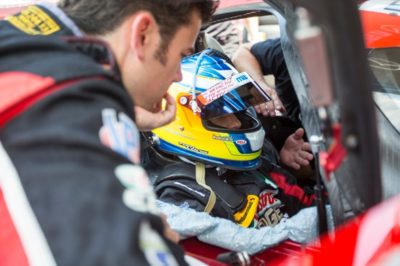This week’s Behind the Zoom blog comes from Tom Long. In addition to being in the driver lineup with the Mazda Prototypes, Tom is an accomplished driver instructor and the man behind the wheel in the development of the 2016 MX-5 Global Cup race car. Today, he offers pro tips for grassroots racers on the proper fit in your race car.
I’ve recently completed several seat fittings in the new Mazda MX-5 Cup car and the SKYACTIV Prototype. Having a seat that has been properly fitted is an important aspect of racing, but one that – unfortunately – many racers overlook. There are a number of reasons why doing a proper seat fitting should be a priority for every racer.
First, the correct seating position is an important safety aspect. Many elements about sitting in a race car are similar to what you were taught long ago about the right seating position in a street car. Make sure the distance to the pedals is correct so you can brake and accelerate easily and still maintain a proper bend in your knee.
Make certain that you’re not reclined too far. It may be comfortable in a street car, but not proper for a race car. If your recline angle is too extreme, the shoulder belts won’t protect you properly in a crash.
Performance is the second reason why a properly fitted seat is important. You can push the pedals more effectively and use the dead pedal as a third touch point to the car, beyond just your back and hands. Have the seat close enough that you have a nice bend in your elbows when your hands are at nine and three on the steering wheel. This lets you drive without straining or leaning forward.
Endurance is the third thing you gain with a seat fitting. More comfort means that your body is relaxed and you can save your energy for the racing. If your seat isn’t right, you’re holding yourself up with the core of your body instead of letting the seat do the work. In endurance racing, especially if you’re doing long or multiple stints, your seat can make the difference between a comfortable race versus cramping in your lower back or getting fatigued too soon.
How to Get The Right Fit:
Do the seat fitting while wearing your HANS Device and helmet. Check your height, field of vision, center of gravity, the bend in your elbows while reaching to the steering wheel, and the bend in your legs as you comfortably reach the pedals. The ideal way to sit in the car is so that your extended arms reach over the top of the steering wheel with your wrists resting on the wheel.
Make sure you have the proper height so you have a good field of vision. This is paired with finding an advantageous center of gravity. Lower is better for handling, but not at expense of sitting high enough to see clearly.
While seated, you will want to make small adjustments, so have someone there to help. Make sure that you set aside adequate time for this – it shouldn’t be an afterthought. Seat position, proper bracketing and fabrication all combine to make up a very important factor in your racing performance.
With the Mazda prototype, the seat is similar to an open-wheel car set-up, with a custom, form-fitting seat that hardens around your body. Co-drivers have to compromise to get closest to the best fit for everyone. It’s very challenging to get the perfect fit for each driver.
Last year, I was teamed with SpeedSource owner Sylvain Tremblay. His shoulders were wider than mine, which allowed more lateral movement than what was ideal for me, especially when cornering. This year, I’m teamed in the No. 07 car with Joel Miller. Joel is taller than me, so we had to compromise on leg length & seat height. It’s critical to not be too far away from the pedals, as a fully extended leg will tire you in a hurry, especially in cars with high G-load. That can be intense when you’re doing long double-stints at a place like Sebring, but it’s equally important even in short sprint races.
So, take the time to do it right. The proper fit means more comfort and safety, plus quicker lap times. And that’s what’s important, right?


 ACCESSIBILITY
ACCESSIBILITY